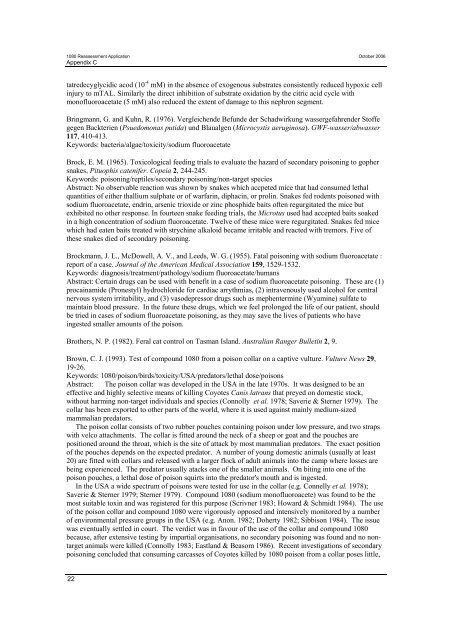Source: Landcare Research (1964). Control of poisons. Royal ...
Source: Landcare Research (1964). Control of poisons. Royal ...
Source: Landcare Research (1964). Control of poisons. Royal ...
You also want an ePaper? Increase the reach of your titles
YUMPU automatically turns print PDFs into web optimized ePapers that Google loves.
1080 Reassessment Application October 2006<br />
Appendix C<br />
tatredecyglycidic acod (10 -4 mM) in the absence <strong>of</strong> exogenous substrates consistently reduced hypoxic cell<br />
injury to mTAL. Similarly the direct inhibition <strong>of</strong> substrate oxidation by the citric acid cycle with<br />
mon<strong>of</strong>luoroacetate (5 mM) also reduced the extent <strong>of</strong> damage to this nephron segment.<br />
Bringmann, G. and Kuhn, R. (1976). Vergleichende Befunde der Schadwirkung wassergefahrender St<strong>of</strong>fe<br />
gegen Backterien (Psuedomonas putida) und Blaualgen (Microcystis aeruginosa). GWF-wasser/abwasser<br />
117, 410-413.<br />
Keywords: bacteria/algae/toxicity/sodium fluoroacetate<br />
Brock, E. M. (1965). Toxicological feeding trials to evaluate the hazard <strong>of</strong> secondary poisoning to gopher<br />
snakes, Pituophis catenifer. Copeia 2, 244-245.<br />
Keywords: poisoning/reptiles/secondary poisoning/non-target species<br />
Abstract: No observable reaction was shown by snakes which accpeted mice that had consumed lethal<br />
quantities <strong>of</strong> either thallium sulphate or <strong>of</strong> warfarin, diphacin, or prolin. Snakes fed rodents poisoned with<br />
sodium fluoroacetate, endrin, arsenic trioxide or zinc phosphide baits <strong>of</strong>ten regurgitated the mice but<br />
exhibited no other response. In fourteen snake feeding trials, the Microtus used had accepted baits soaked<br />
in a high concentration <strong>of</strong> sodium fluoroacetate. Twelve <strong>of</strong> these mice were regurgitated. Snakes fed mice<br />
which had eaten baits treated with strychine alkaloid became irritable and reacted with tremors. Five <strong>of</strong><br />
these snakes died <strong>of</strong> secondary poisoning.<br />
Brockmann, J. L., McDowell, A. V., and Leeds, W. G. (1955). Fatal poisoning with sodium fluoroacetate :<br />
report <strong>of</strong> a case. Journal <strong>of</strong> the American Medical Association 159, 1529-1532.<br />
Keywords: diagnosis/treatment/pathology/sodium fluoroacetate/humans<br />
Abstract: Certain drugs can be used with benefit in a case <strong>of</strong> sodium fluoroacetate poisoning. These are (1)<br />
procainamide (Pronestyl) hydrochloride for cardiac arrythmias, (2) intravenously used alcohol for central<br />
nervous system irritability, and (3) vasodepressor drugs such as mephentermine (Wyamine) sulfate to<br />
maintain blood pressure. In the future these drugs, which we feel prolonged the life <strong>of</strong> our patient, should<br />
be tried in cases <strong>of</strong> sodium fluoroacetate poisoning, as they may save the lives <strong>of</strong> patients who have<br />
ingested smaller amounts <strong>of</strong> the poison.<br />
Brothers, N. P. (1982). Feral cat control on Tasman Island. Australian Ranger Bulletin 2, 9.<br />
Brown, C. J. (1993). Test <strong>of</strong> compound 1080 from a poison collar on a captive vulture. Vulture News 29,<br />
19-26.<br />
Keywords: 1080/poison/birds/toxicity/USA/predators/lethal dose/<strong>poisons</strong><br />
Abstract: The poison collar was developed in the USA in the late 1970s. It was designed to be an<br />
effective and highly selective means <strong>of</strong> killing Coyotes Canis latrans that preyed on domestic stock,<br />
without harming non-target individuals and species (Connolly et al. 1978; Saverie & Sterner 1979). The<br />
collar has been exported to other parts <strong>of</strong> the world, where it is used against mainly medium-sized<br />
mammalian predators.<br />
The poison collar consists <strong>of</strong> two rubber pouches containing poison under low pressure, and two straps<br />
with velco attachments. The collar is fitted around the neck <strong>of</strong> a sheep or goat and the pouches are<br />
positioned around the throat, which is the site <strong>of</strong> attack by most mammalian predators. The exact position<br />
<strong>of</strong> the pouches depends on the expected predator. A number <strong>of</strong> young domestic animals (usually at least<br />
20) are fitted with collars and released with a larger flock <strong>of</strong> adult animals into the camp where losses are<br />
being experienced. The predator usually atacks one <strong>of</strong> the smaller animals. On biting into one <strong>of</strong> the<br />
poison pouches, a lethal dose <strong>of</strong> poison squirts into the predator's mouth and is ingested.<br />
In the USA a wide spectrum <strong>of</strong> <strong>poisons</strong> were tested for use in the collar (e.g. Connelly et al. 1978);<br />
Saverie & Sterner 1979; Sterner 1979). Compound 1080 (sodium mon<strong>of</strong>luoroacete) was found to be the<br />
most suitable toxin and was registered for this purpose (Scrivner 1983; Howard & Schmidt 1984). The use<br />
<strong>of</strong> the poison collar and compound 1080 were vigorously opposed and intensively monitored by a number<br />
<strong>of</strong> environmental pressure groups in the USA (e.g. Anon. 1982; Doherty 1982; Sibbison 1984). The issue<br />
was eventually settled in court. The verdict was in favour <strong>of</strong> the use <strong>of</strong> the collar and compound 1080<br />
because, after extensive testing by impartial organisations, no secondary poisoning was found and no nontarget<br />
animals were killed (Connolly 1983; Eastland & Beasom 1986). Recent investigations <strong>of</strong> secondary<br />
poisoning concluded that consuming carcasses <strong>of</strong> Coyotes killed by 1080 poison from a collar poses little,<br />
22








![Application for test certificate [pdf, 131kb]](https://img.yumpu.com/50666502/1/184x260/application-for-test-certificate-pdf-131kb.jpg?quality=85)








